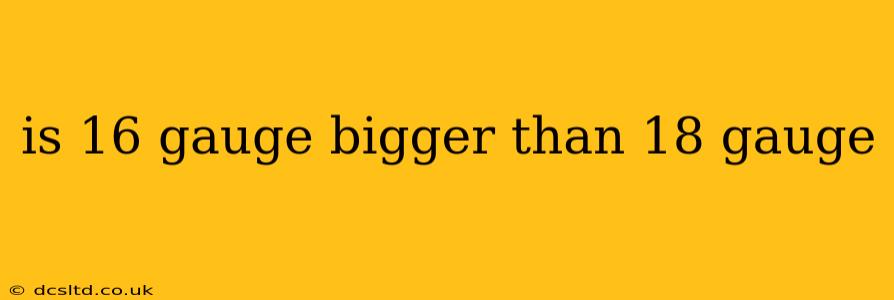Is 16 Gauge Bigger Than 18 Gauge? Understanding Wire Gauge
The simple answer is yes, 16-gauge wire is bigger than 18-gauge wire. This might seem counterintuitive at first glance, but understanding the system of wire gauge helps clarify this.
Wire gauge is a standardized system that measures the diameter of a wire. The lower the gauge number, the thicker the wire. Think of it like this: a smaller number represents a larger diameter. Therefore, a 16-gauge wire has a larger diameter and carries more current than an 18-gauge wire.
Why Does a Lower Number Mean a Larger Diameter?
The American Wire Gauge (AWG) system is based on a logarithmic scale. This means each gauge number doesn't represent a fixed increase or decrease in diameter; rather, the diameter changes by a consistent ratio. This system dates back to the 1850s and has remained largely consistent for historical reasons and practical applications. While seemingly confusing at first, this scale ensures that small differences in gauge numbers reflect significant changes in the wire's physical properties.
What are the practical implications of this difference?
The difference between 16-gauge and 18-gauge wire impacts several key factors:
-
Current Carrying Capacity: 16-gauge wire can safely handle a higher electrical current than 18-gauge wire due to its larger cross-sectional area. This means it's suitable for applications requiring more power.
-
Resistance: 18-gauge wire has higher resistance than 16-gauge wire. Higher resistance leads to more heat loss, which can be a safety concern and reduce efficiency.
-
Applications: 16-gauge wire is often used for higher-current applications like appliance wiring and some automotive applications. 18-gauge wire is commonly used for lower-power applications, such as lamp cords or wiring for less demanding electronic devices.
What other gauges are commonly used and how do they compare?
There's a wide range of wire gauges, each suited for different applications. Here are a few examples:
- 14 Gauge: Even thicker than 16 gauge, used for high-current applications.
- 20 Gauge: Thinner than 18 gauge, often used for low-power electronics and small projects.
- 22 Gauge: Even thinner than 20 gauge, typically used for very low current applications.
You will frequently see these gauges listed in electrical specifications and when purchasing wires and cables.
How can I determine the gauge of a wire?
Various methods exist to determine a wire's gauge, including:
- Wire Gauge Tool: A specialized tool that measures the diameter of the wire.
- Wire Gauge Chart: Consult a chart that shows the diameter of different gauge sizes. Online resources and electrical handbooks often include these charts.
- Wire Stripper: Some wire strippers include a gauge measurement feature.
Understanding wire gauge is crucial for ensuring electrical safety and selecting the appropriate wire for specific applications. Choosing the incorrect gauge can lead to overheating, fire hazards, and equipment failure. Therefore, always consult appropriate electrical codes and guidelines for your specific project or location.
